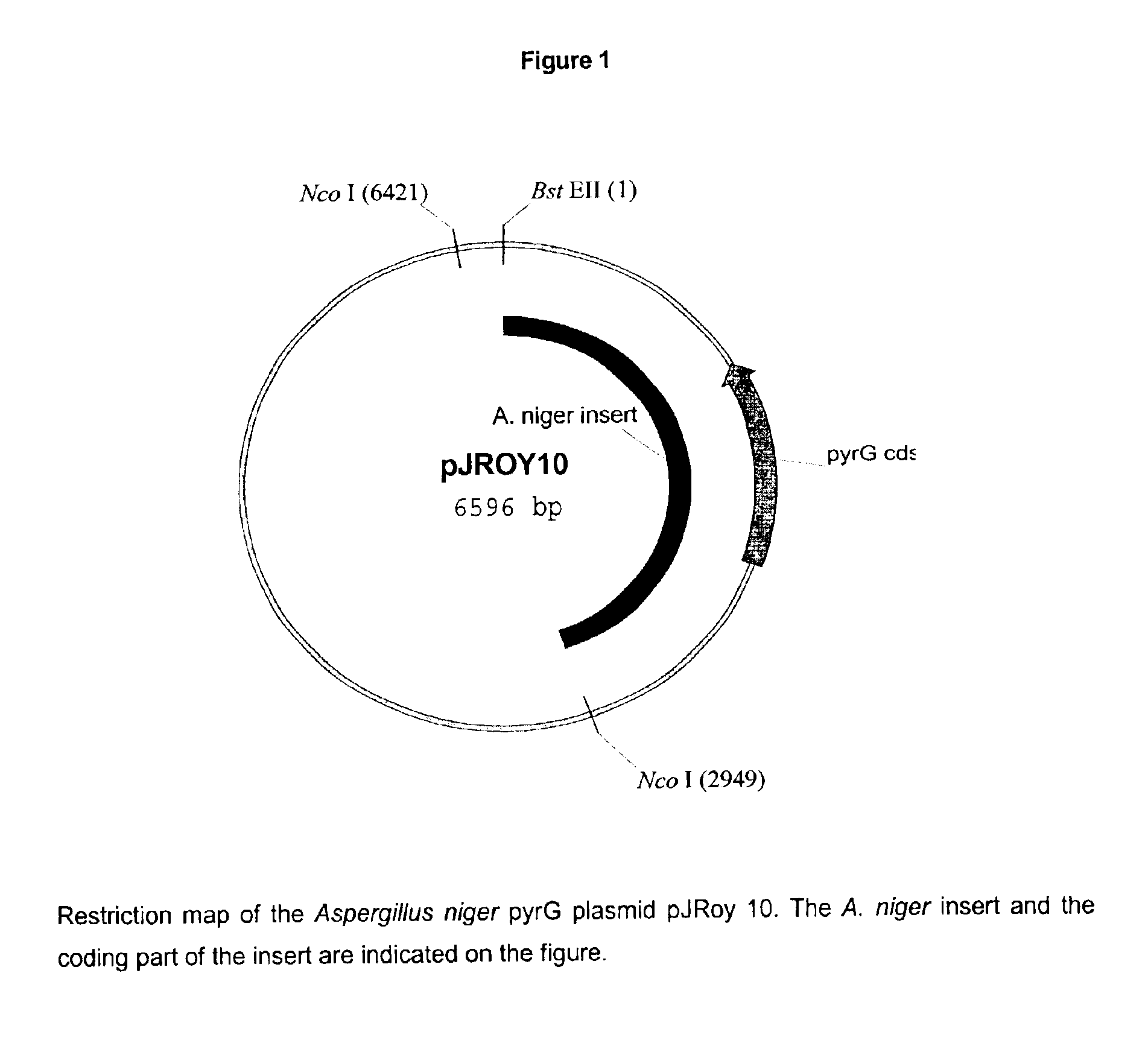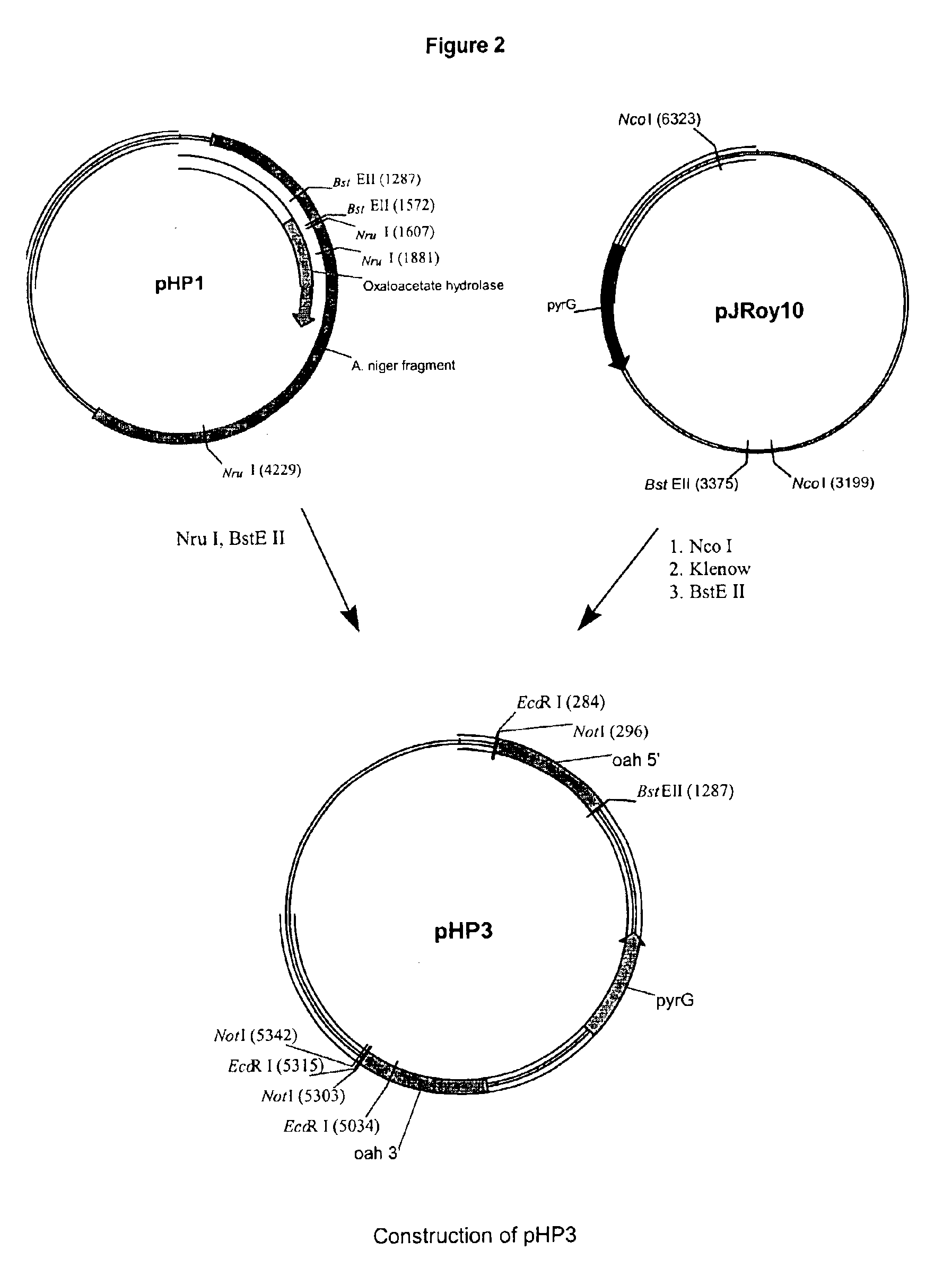Method of producing a polypeptide using oxaloacetate hydrolase deficient fungal host cells
a technology of oxaloacetate hydrolase and polypeptide, which is applied in the direction of lyase, transferase, enzymology, etc., can solve the problems of oxalic acid production undesirably, high cost, and high cost of oxalic acid, and achieve the effect of less oxaloacetate hydrolas
- Summary
- Abstract
- Description
- Claims
- Application Information
AI Technical Summary
Benefits of technology
Problems solved by technology
Method used
Image
Examples
example 1
Purification of the Oxaloacetate Hydrolase (EC 3.7.1.1)
[0125]Aspergillus niger BO1 was fermented in shake flasks at 30° C. in the medium: sucrose 20 g / L, NaNO3 15 g / L, KH2PO4 1.5 g / L, MgSO4, 7H2O 1 g / L, NaCl 1 g / L, CaCl2, 2H2O 0.1 g / L, trace solution 0.5 ml / L. Trace solution: ZnSO4, 7H2O 14.3 g / L, CuSO4, 5H2O 2.5 g / L, NiCl2, 6H2O 0.5 g / L, FeSO4, 7H2O 13.8 g / L, MnCl2 6 g / L. The pH was 2.5 until a biomass concentration of about 0.5 g / L was reached. Then the pH was shifted to 6 by addition of 2 M NaOH and the cells were grown until the biomass concentration reached about 5 g / L. The cells were harvested by filtration, washed with 0.9% (w / v) NaCl and then frozen in liquid nitrogen. The frozen cells were disrupted in a morter under liquid nitrogen and then suspended in buffer A. The suspension was centrifuged (15 min, 40.000×g, 4° C.), and the supernatant was isolated. Ammoniumsulphate was added to 45% saturation (277 g / l), and the formed suspension was centrifuged (15 min, 40.000×g, 4° C...
example 2
Protein Sequence Determination of Fragments of the Oxaloacetate Hydrolase
[0129]The purified oxaloacetate hydrolase of example 1 was subjected to SDS-PAGE gel electrophoresis on a 12.5% gel using standard methods (Laemmli, U. K., Cleavage of structural proteins during the assembly of the head of bacteriophage T4, Nature, 227: 680-685 (1970)). The proteins were blotted onto a PVDF membrane by electroblotting, and the membrane was stained with Coomassie brilliant blue R-250 as described by Plough et al (Plough M, Jensen A L and Barkholt V., Anal. Biochem., 181: 33-39 (1989)). 4 protein bands in the range of an apparent molecular weight of 38 to 40 kD were excised and applied for amino terminal sequencing using a Procise −494 protein sequencer from PerkinElmer—Applied Biosystems, Norwalk, Conn., USA following the manufacturer's instructions. The following sequences were obtained:[0130]1. MKVDTPDSASTISMTN (SEQ ID NO: 3)[0131]2. TNTITITVEQDGIYE (SEQ ID NO: 4)[0132]3. VEQDGIYEIN (SEQ ID NO...
example 3
Cloning of the Gene Encoding the Oxaloacetate Hydrolase
[0134]The protein sequences determined in example 2 were used for database searches, and an Aspergillus niger EST sequence was retrieved (EMBL, T82752, AN752). This EST encoded a protein sequence that could be aligned to the four sequences from example 2 with 100% identity. The EST sequence was used to design the following PCR primers:
[0135]
Oxalac EST sense:5′ AAA GTT GAT ACC CCC GAT TCT 3′(SEQ ID NO: 7)Oxalac EST antisense:5′ ATG GCA ATA CGG GGA CAG ACC 3′.(SEQ ID NO: 8)
[0136]These primers were used to amplify DNA from A. niger BO 1 prepared essentially as described by Leach et. al. (J. Leach, D. B. Finkelstein and J. A. Rambosek, Fungal Gent. Newsl., 33: 32-33 (1986)) using amplitaq taq polymerase from PerkinElmer (Norwalk, Conn., USA) following the manufacturer's instructions. The PCR reaction was run in an MJ PCT 150 capillary PCR cycler (MJ research, Watertown, Mass., USA in a volume of 10 microliters running 30 cycles with...
PUM
| Property | Measurement | Unit |
|---|---|---|
| Temperature | aaaaa | aaaaa |
| Temperature | aaaaa | aaaaa |
| Fraction | aaaaa | aaaaa |
Abstract
Description
Claims
Application Information
 Login to View More
Login to View More - R&D
- Intellectual Property
- Life Sciences
- Materials
- Tech Scout
- Unparalleled Data Quality
- Higher Quality Content
- 60% Fewer Hallucinations
Browse by: Latest US Patents, China's latest patents, Technical Efficacy Thesaurus, Application Domain, Technology Topic, Popular Technical Reports.
© 2025 PatSnap. All rights reserved.Legal|Privacy policy|Modern Slavery Act Transparency Statement|Sitemap|About US| Contact US: help@patsnap.com


